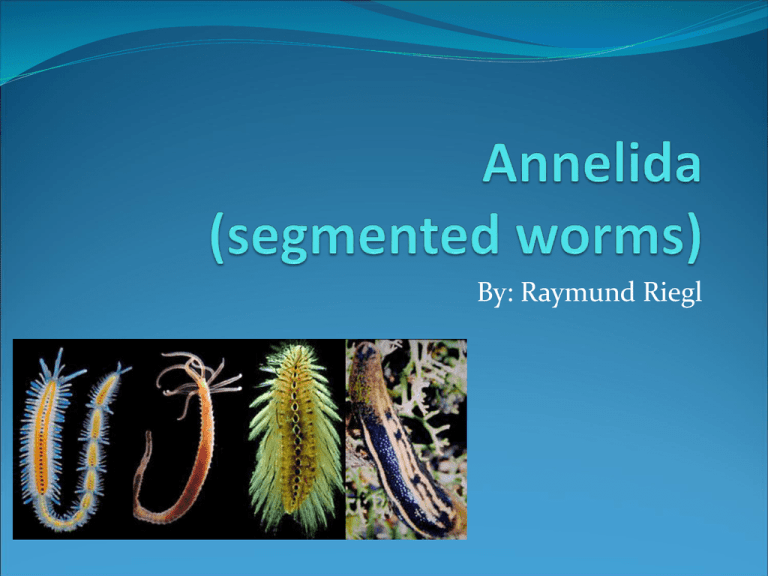
By: Raymund Riegl
Characteristics of Annelids
Annelida means “little rings.”
There are about 15,00 annelid species, ranging from
less than 1 mm to the 3-m length. (giant Australian
earthworm)
All members of the group are to some extent
segmented. (a.k.a metamerism) This increases the
efficiency of body movement by allowing the effect of
muscle contraction to be extremely localized, and it
makes possible the development of greater complexity
in general body organization.
Annelids are schizocoelous.
Hydrostatic pressure is maintained across segments
and helps maintain body rigidity, allowing muscle
contractions to bend the body without collapsing it.
The internal organs of annelids are well developed.
They include a closed, segmentally-arranged
circulatory system, and digestive system. Gases are
exchanged through the skin. Each segment typically
contains a pair of nephridia.
Annelids may be monoecious or dioecious. Larva may
or may not be present; if present they are of the
trochophore type. Some forms also reproduce
asexually.
Annelids have some combination of tactile organs,
chemoreceptors, balance receptors, and
photoreceptors.
The nervous system includes a pair of cephalic ganglia
attached to double nerve cords that run the length of
the animal along the ventral body wall.
Biochemical Evidence
Classifications of the Phylum
Oligochaeta (terrestrial and freshwater segmented
worms; e.g., earthworms)
Polychaeta, (mostly marine segmented worms)
sometimes referred to as bristle worms. Common
representatives include the lugworm, and the sandworm.
Hirudinea, Commonly referred to as Leeches.
Morphology of Oligochaeta
(earthworms)
Earthworm is the common name for the largest members
of Oligochaeta.
Educed head; no parapodia, but setae present.
The basic body plan of an earthworm is a tube, the
digestive system, within a tube, the muscular slimy, moist
outer body. It has several specialized regions: the pharynx,
the esophagus, the crop, the gizzard, and the intestine.
Earthworms have a simple circulatory system. A typical
earthworm will have 5 hearts. Tiny blood vessels are
abundant in the earthworm’s skin, which functions as its
reparatory organ.
Morphology continued
A brain like pair of cerebral ganglia lies above and in
front of the pharynx. A ring of nerves around and in
front of the pharynx connects to a sub-pharyngeal
ganglion, form which a fused pair of nerve cords run
posteriorly.
Anatomy of an earthworm
Embryology of the earthworm
It will generate their earliest segments during larval
life. Larval segments arise from a field of dividing cells
located in lateral regions of the body.
The larva emerges as small, but fully formed
earthworms, except for a lack of the sex structures,
which develop later in about 60 to 90 days.
Life History
The worms hatch as smaller earthworms that lack
reproductive organs; this is the main difference
between newly hatched worms and the fully
developed. The worms start to develop reproductive
organs after they are hatched. They are able to use
their reproductive organs at around 12 months.
Earthworms can sometimes live for more than 10 years
depending on the species.
Morphology of Polychaeta
Clam worms, sand worms, and tubeworms range in
length from 0.078 inches to 9.8 feet. Their bodies
consist of a head, body trunk, and tail.
Most species have long, segmented bodies that are
tube like and covered with bristles. Along the sides of
their bodies are flaps that help them to swim, burrow,
draw bits of food suspended in the water to their
mouths, and grip surrounding rocks, sand, or mud.
The side flaps are also used like gills to help them
breathe underwater.
Morphology continued
They vary in color, ranging from clear to light tan, red,
pink, green, yellow, or a combination of these and other
colors.
Their body shapes also vary and usually reflect their
lifestyles. Active species, such as those that hunt for their
food and some burrowers, have bodies with segments that
are all very similar in appearance to one another.
They have well-developed flap like appendages, eyes, and
other sensory organs. Some of these species have a mouth
with tough jaws and the ability to extend part of their
digestive tract outside the body to feed.
Anatomy of Polychaeta
Embryology
The embryo is transparent giving insight into the
dynamic structures and processes inside the cells that
accompany the prevailing anisotropic cleavages.
s they develop, additional segments are formed behind
a special growth zone.
Live History
Their lifespan can range from a few weeks to several
years.
A unique feature of this animal within the phylum is
the shape of the Christmas-tree worm.
Morphology of Hirudinea
Fully mature adults can be up to 20cm in length.
Leeches have eyespots on the head that are able to
detect movement from contrasting patterns of light
and shadow.
Leeches are not covered with stiff bristles nor do they
have paddle like flaps.
These organisms have two suckers, one at each end,
called the anterior and posterior sucker. The posterior
is mainly used for leverage while the anterior sucker,
consisting of the jaw and teeth, is where the feeding
takes place.
Morphology continued
The incision leaves a mark which is an inverted Y
inside of a circle.
After piercing the skin and injecting anticoagulants (Hirudin) and anaesthetics they suck
out blood. Large adults can consume up to ten times
their body weight in a single meal.
Leeches can live for up to a year between feeding.
Anatomy of Hirudinea
Embryology
Once mating has occurred, The cocoons are either left
in the soil, or attached to the bodies of other animals.
Fish leeches attach their egg cases to the bodies of
crustaceans, or water-dwelling animals.
Life History
Leeches are capable of living 1 or more years.
It is a parasitic species.
It is disease causing when it is removed by burning.
Conclusion
All Annelida are segmented.
Live in water and or land.
Are basically elongated tubes that move.
Some may be parasitic and venomous

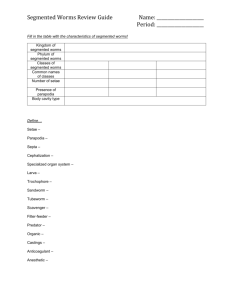
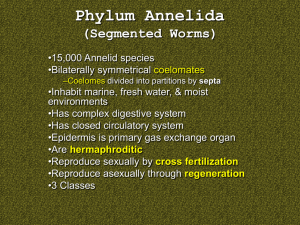
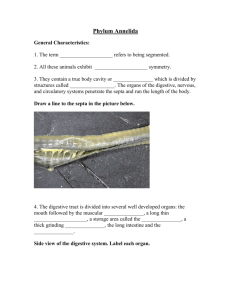


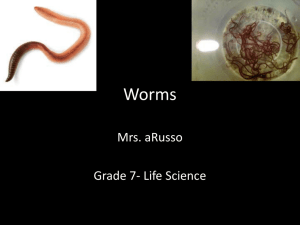
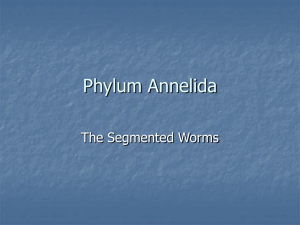
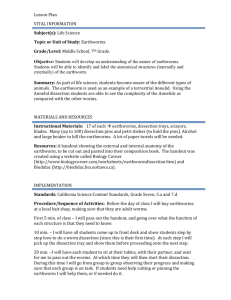
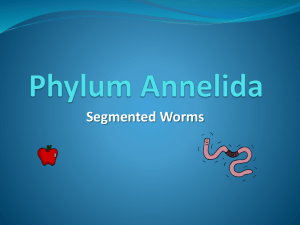
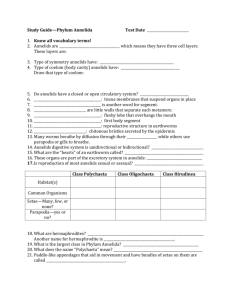

![earthworm [annelid – segmented worm]](http://s3.studylib.net/store/data/008502476_1-3ebb28d32ff3e90b09ed01ec69126429-300x300.png)